Researchers continue to release research on the potential dangers of blue light. When you stare at screens all day and into the evening, it can affect your sleep and disrupt your body’s natural rhythm. For this reason, blue light filters are essential.
Whether you spend your day on a Windows PC, Mac, or Chromebook, you should enable a blue light filter to help ease the strain on your eyes. Desktop and laptop screens usually have built-in filters that you can access, and there are downloadable options if your computer doesn’t have this feature.
However, if you are looking for a blue light filter for your smartphone, there are many great apps you can download from the Google Play Store or iOS App Store.
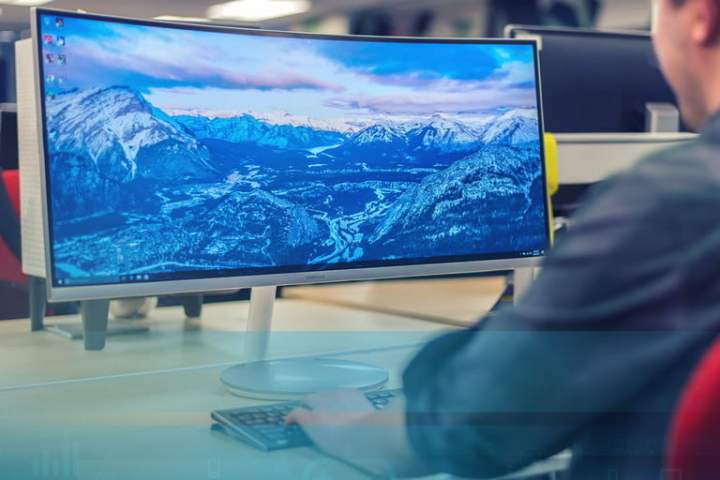
Image used with permission of the copyright holder
What’s the deal with blue light?
The reason blue light hurts is purely biological. Sleep is part of the circadian rhythm, a cycle of biological processes that is determined in part by the levels of light and darkness to which our bodies are exposed.
In the most natural conditions, namely when we are only exposed to sunlight, our retinas perceive when the sun sets and the environment becomes darker. This prompts our hypothalamus to start the process of producing melatonin and other sleep hormones and lowers our body temperature.
However, if we use artificial lighting to lengthen the day, our body becomes confused and various sleep signals are disrupted. What’s even worse is blue light emitted by neon lights and LED lights — like those on our various device screens — that cause us to be more alert and produce less melatonin.
That’s why using a blue light filter is so important.
Windows 10
Microsoft added a blue light limiting feature to Windows 10 in The Creators Update was released in April 2017. Called Night Light, this feature shifts the appearance of Windows 10 and 11 to display warmer colors that reduce the amount of blue light emitted. Enabling this feature is a simple process.
Step 1: Right click on Beginning button and select Arrangement in Electricity Users menu. Alternatively, you can press Window + X lock then click Arrangement.
Step 2: Choose System in the pop-up window.
Step 3: In Windows 10, Displaying categories are open by default. In Windows 11, you have to select it from the list of categories on the right. Scroll down on the right and enable it Night light arrangement. In Windows 11, you will find the settings at Brightness & color part.
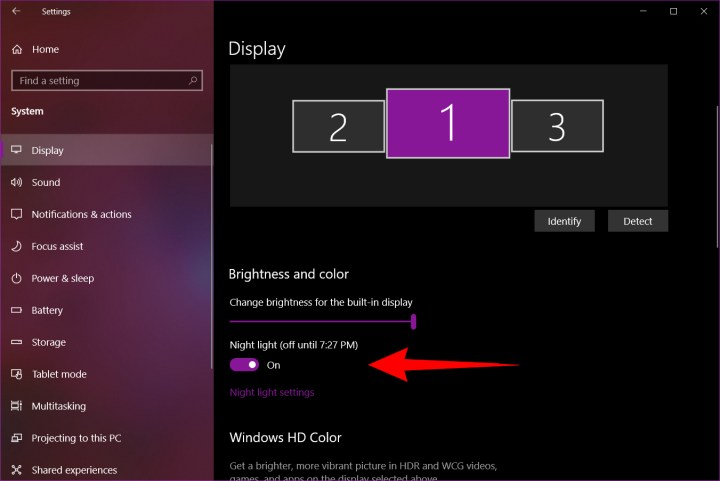
Kevin Parrish / Digital Trends
Step 4: To configure the Night Light feature, click Night Light Settings link located under the switch. Here, you’ll find options to immediately turn on the Night Light, adjust its strength, and schedule times to turn it on and off. In Windows 11, press the right arrow key to access this setting.

Kevin Parrish / Digital Trends
Step 5: To set a schedule, activate it Schedule Night Light option to activate. Then, you can choose to leave it be Night light turns on at sunset and turns off at sunrise — automatically determined by your location — or you can set the time manually by clicking Set Hours and choose when the feature should be turned on and off.
When you first enable this feature, you will immediately notice a color change. After a while, your eyes will adjust to the changes, and they will become less noticeable. However, by reducing the amount of blue light, the Night Light feature will limit the impact of using your Windows PC at night — you’ll fall asleep more easily, and your sleep may be more restful and restful.

Image used with permission of the copyright holder
macOS
First introduced in iOS, Apple brought Night Shift to Mac in macOS Sierra in March 2017. Like Windows, this feature is easy to enable and configure to your taste.
Step 1: Click Apple logo in the top left corner and select it System Preferences in the drop-down menu. Alternatively, click the System Preferences icon on Dock. In macOS Ventura and later, the utility is called System settings.
Step 2: Choose Displaying in the pop-up window. On macOS Ventura and later, select Displaying from the category list on the left.
Step 3: Click Night Shift tab in the following pop-up window.
Here, you can configure when Night Shift automatically run, turn it on until the next sunrise, and set your preferred color temperature. For scheduling, you can let macOS turn it on and off at sunset and sunrise based on your location, or you can set a custom schedule.
Like the Night Light feature in Windows 10, Apple’s Night Shift makes your screen colors warmer and reduces the amount of blue light emitted. Try it to see if it improves your sleep habits and helps you be healthier, more productive, and generally a happier Mac user.
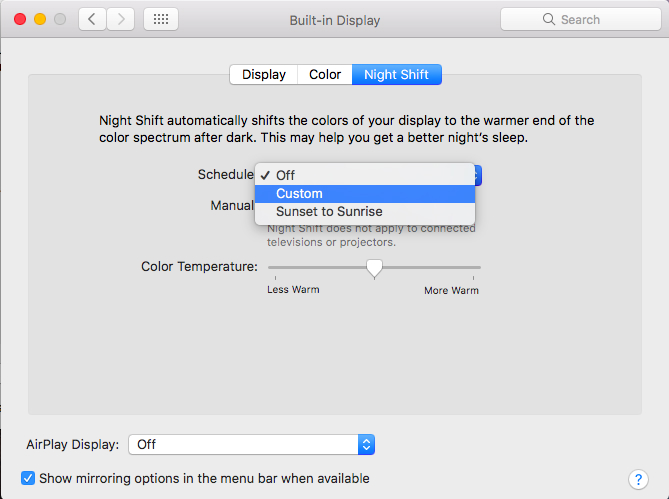
Mark Coppock / Digital Trends
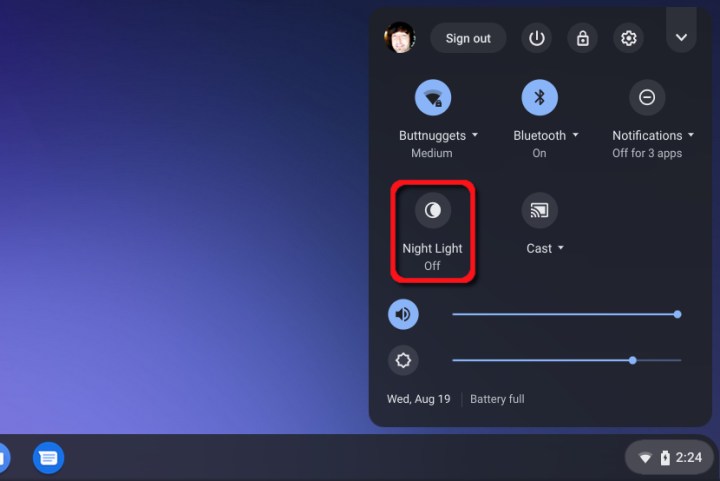
Kevin Parrish / Digital Trends
Chromebooks
Google’s Chrome OS-based devices have a built-in blue light filter called Night Light. The easiest way to activate this feature is to click System clock followed by Night light button on the pop-up menu. The screen is automatically washed with a dark yellow hue.
For more control over Night Light, do the following:
Step 1: Click on System clock and select Tooth icon on the pop-up menu. It opens Arrangement window.
Step 2: Choose Device listed on the left.
Step 3: Choose Displaying listed on the right.
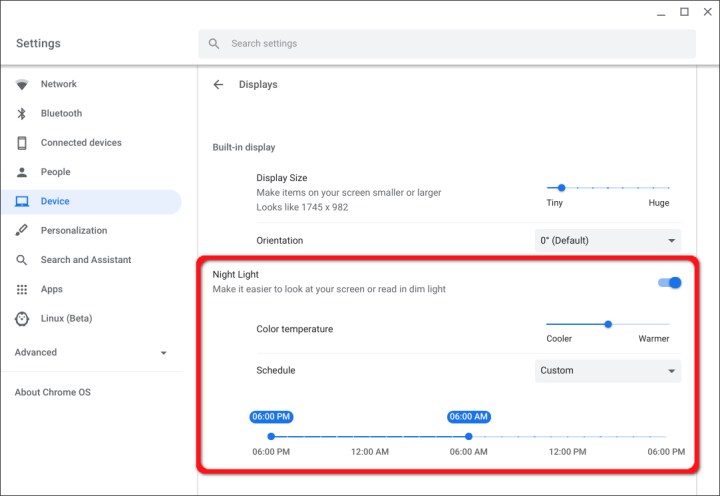
Kevin Parrish / Digital Trends
Step 4: Click on the button located on the right Night light to enable this feature. On macOS Ventura and later, click Night Shift… at the bottom of the window to open settings.
Step 5: Move the slider in between Cooler And Warmer to adjust the blue light level.
Step 6: Next to Timetableclick Down Arrow choose Never, Sunrise to sunsetor Habit.
Step 7: If you choose HabitTime line appears from 6pm to 6pm Select the duration by moving the start time and stop time accordingly.
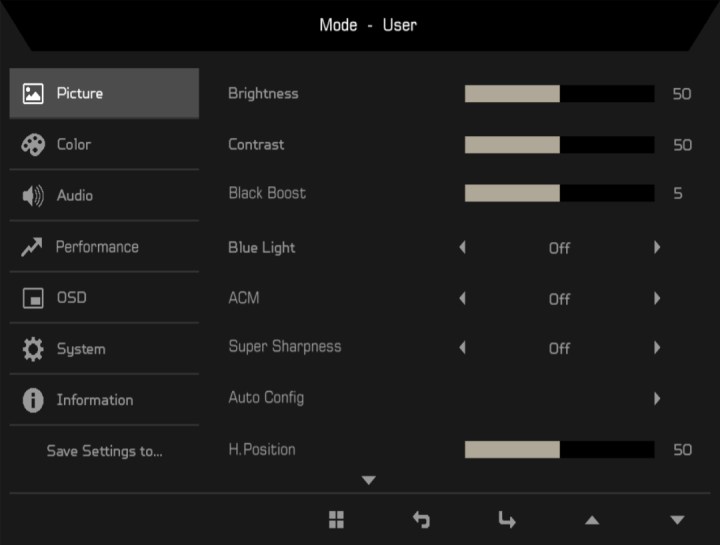
Acer plant
External view
While you can change blue light levels through software, external monitors may include a blue light filter that you can manage with integrated On Screen Display (OCD) controls.
For example, press OCD button on the Acer SB220Q’s 21.5-inch display, and the control panel appears on a separate screen from the PC desktop. As shown above, it includes options to adjust brightness, sharpness, and blue light. You can manually switch between 50% to 80%. You will get more blue light as you increase this value.
Overall, it is easier to adjust blue light levels directly through your computer’s operating system compared to doing it on the monitor. On the other hand, if you use the same monitor for multiple devices, changing the settings on the side of your monitor may be a much easier approach.
Third party alternatives
Genre:
F.lux is an innovative third-party alternative for customizing your monitor’s color levels. This technology carefully monitors sunlight levels in your area and adjusts the color temperature of your screen accordingly. This is available for free for Windows, macOSAnd Linux. You can also use it to control the lights in your home by pairing it with a smart lighting system. You can turn off this feature whenever you want by toggling the switch.
IrisMini:
Iris Mini is a very light and impressive blue light filter app. This is an efficient option; no additional UI, buttons or steps. This feature can automatically adjust the colors on your monitor to minimize the effects of glare or blue light. You can change the settings manually or rely on Iris Mini’s automatic feature. Auto mode evaluates time and adjusts color. There are versions available for Windows, Mac, and Linux.
Editor’s Recommendations